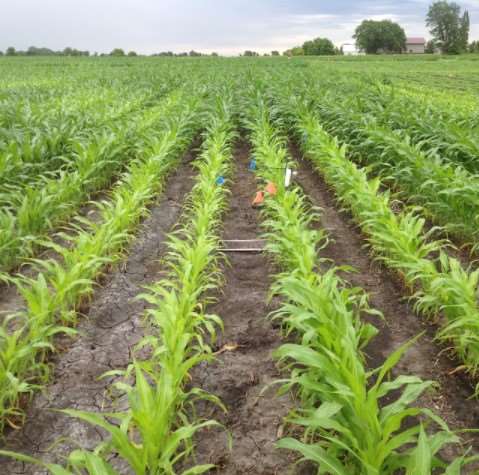By Greg Klinger, Fabian Fernandez & Dan Kaiser
Wondering whether you should apply supplemental nitrogen to your corn fields this year? Find your answer with University of Minnesota Extension’s Supplemental Nitrogen Worksheet for Corn. Meant to be used in early to mid-June, this useful tool asks 3 simple questions of growers and provides a score that rates the need for additional nitrogen fertilizer. High scores mean that supplemental N should be applied, medium scores suggest taking a “wait and see” approach, and low scores mean no supplemental N should be needed.
When did you apply?
The first question asks when a farmer applied the bulk of their nitrogen fertilizer, whether they used an inhibitor with the fertilizer and what soil temperatures were at the time. The answer determines how much conversion to nitrate was likely to occur with their nitrogen fertilizer. This is important because the
bulk of nitrogen losses occur when it is in the nitrate form.
How was May weather?
The second question asks what the weather and soil conditions were during the month of May, a month when soil temperatures are typically warm enough to result in quick conversion of fertilizer nitrogen to nitrate. If conditions were wetter than usual, there is also more likelihood of nitrogen loss.
What does the crop look like?
The third question asks how the corn crop looks in the field, assessing color and height. A tall, yellow or pale green corn crop is more likely to need supplemental N than a short, yellow or pale green corn crop, which is more likely to need N than a short, “normal” green-colored corn crop. The least likely to need supplemental N is a field of tall, normal green colored corn.
Why would tall and yellow be worse than short and yellow, but tall and green be better than short and green? The answer has to do with when corn is taking up nitrogen, and when pale, sickly corn is likely to be a result of nitrogen deficiency rather than something else.
All other things being equal in the field, taller corn in the spring normally means the corn is further along in development. Nitrogen uptake is fairly slow until around the V8 growth stage. By V3, only around 10 pounds/acre of nitrogen has been used by the corn crop; at V6, the corn crop has only taken up around 25 pounds/acre of nitrogen from the soil. A taller corn plant, closer to the V8 growth stage, will be more dependent on nitrogen from the soil for its growth. It also has a much shorter window between when it’s examined in the field and when nitrogen deficiency can start limiting its yield potential. Yellowing on a corn plant very early in its development is often due to poor growth conditions, like too wet of fields or cool and dry, and may grow out of its deficiency symptoms as conditions improve. There’s a better likelihood that a “wait and see” strategy will work best for early-development stage corn that is yellow or pale green in color, so short yellow corn is rated lower than tall yellow corn.

On the other hand, short green corn is more of a concern than tall green corn purely because it’s not as far along in its development. This means that nitrogen deficiency symptoms may not have had time yet to develop, or that less-than-ideal weather conditions have led the plant to develop more slowly. Oftentimes, these less-than-ideal conditions can be the same conditions that result in nitrogen losses in wet or waterlogged soils.
Interpreting results
If your results recommend applying more nitrogen, University of Minnesota Extension recommends 40 to 70 pounds/acre. Under these conditions, the best return on investment is usually between 40 and 60 pounds of nitrogen/acre- it is very rare to see a yield response to more than 80 pounds of supplemental nitrogen when a full rate was applied before planting.